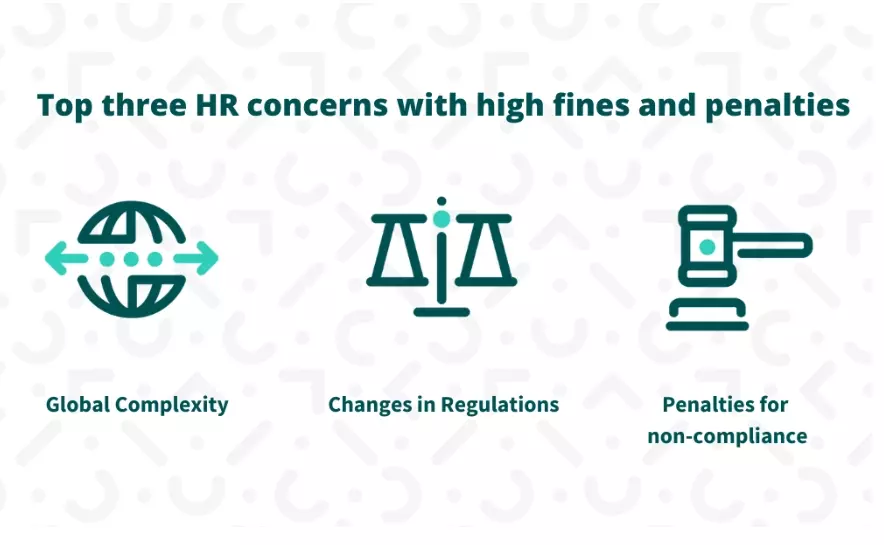A Changing Legal Environment
More than a third of HR professionals fail to keep track of regulatory developments. Given the burden of responsibility of HR, they need and deserve an agile solution, made possible by digital transformation — to reduce the risks of non-compliance and enable employees to benefit from the best possible support.
The health crisis, the EU–UK Trade and Cooperation Agreement (Brexit), the forthcoming entry into force of the Artificial Intelligence Act… There can be no doubt that HR professionals are facing a steady torrent of regulatory changes. Within this context, it is essential that companies develop a strategy for HR compliance. But given the proliferation of technological, social and other changes, HR professionals have a hard time complying with all the regulatory changes. In fact, it is stated that the average cost of non-compliance is higher than $14.82 million, which represents an increase of 45% over the past ten years.
A new approach must be taken that will allow HR teams, as far as possible, to anticipate changes in the new legal framework, or at least react as quickly as possible in order to implement the new measures and ensure that companies remain on the right track.
Agile Compliance Checklist
The main concerns of HR regarding compliance rely on three main factors: managing global complexity, complying with changes in regulations and dealing with penalties for non-compliance. In fact, according to a survey conducted by the European Business Awards on behalf of RSM, 30% of European businesses are still not compliant with GDPR. Each element contributes to additional HR concerns as a single mistake comes with high fines and penalties. Thus, HR doesn’t have the right to make mistakes, which explains their increased focus on compliance.

To avoid the costly consequences of non-compliance, HR should be meticulous and arm themselves with the right tools that will allow them enough flexibility to both manage internal admin processes and comply with constantly evolving regulations.
Compliance Training
Employees feel at ease knowing their new employer is on top of the latest privacy practices. The first step to ensuring compliance is to receive HR compliance training and be up to date with all changes regarding statutory compliance, regulatory compliance and contractual compliance.
Frequent Compliance Audit
Frequently auditing all the main areas that your HR department needs to be compliant with can help you analyse the degree of compliance of your organisation. To do this, create a checklist with all the specific topics that can have an impact within your HR department. It could be a document, a policy or a procedure.
For instance, you can audit your employee handbook, company guidelines, training, stand-alone policies or procedures related to annual leave, sick leave, complaint procedure, internal investigation, contract termination, and so on. Checking that all the policies, forms and information shared with your employees are consistent, standard, accessible and acknowledged should also be included in the checklist.
With the right tools, auditing can take a few clicks instead of days of search.
Stay Ahead Of Compliance
Compliance should be managed proactively using a single platform that allows you enough flexibility to know in advance what documents are missing or about to expire before it’s too late. Agile HR teams think ahead by storing documents electronically in a system that makes it easy to tag, file, and search those documents, with fast and simple reporting capabilities. HR can proactively manage compliance by collecting missing files or requesting recertifications — staying far ahead of an audit or a lawsuit. And with simple reporting, it becomes easy to prove compliance to internal and external stakeholders.
Be Proactively Compliant
Another aspect of laws and regulations is constant change — and HR departments are fast on their feet in taking up the challenge. We see that a lot of companies are managing to adapt faster than the government. Even before the lockdown was announced in March 2020, organisations had already instigated remote working and cancelled business travel — several weeks before the adoption of emergency legislation aimed at combating the Covid-19 pandemic.
In short, companies that are proactive where compliance is concerned are gaining the ability to stay ahead of directives and avoid sanctions. By keeping an eye on trends within their sector, but also on public opinion, they are remaining a step ahead because they have understood that the long-term penalties resulting from delays or a reluctance to adapt within their field are even worse than the short-term ones.
How Can HR Reach Agile Compliance?
Agile compliance means going beyond basic compliance in order to help shape trends, while at the same time, improving the client and employee experience. These companies do not merely respect the regulations; they understand that their sector demands more than just the bare minimum and that, over time, further changes are to be expected.
Digital transformation and the automation of HR processes offer the triple advantage of enabling rapid adaptation and ensuring the security of HR teams on a daily basis, freeing up time that can then be dedicated to tasks offering high added value, and generating data that can be exploited through HR analytics.
It is time for organisations to take advantage of technological advances in order to improve their agility, anticipate better and remain compliant. New technologies are the key to HR agility and help teams implement more relevant processes, adapt to evolving policies and regulations and provide employees with high-end services. Now that the movement is underway, let us continue down this road.

